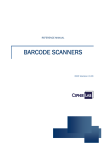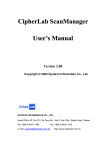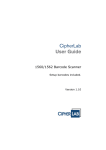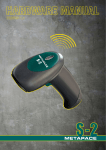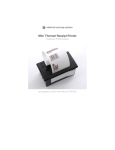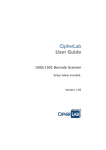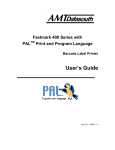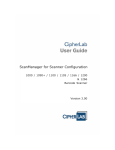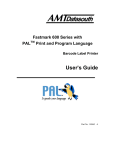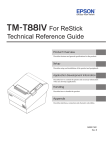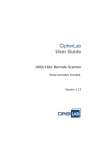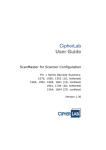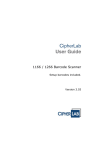Download CipherLab 1562 User guide
Transcript
ScanMaster for Scanner Configuration
1500/1560/1562/1660 Barcode Scanner
Version 1.10
Copyright © 2008 ~ 2009 CIPHERLAB CO., LTD.
All rights reserved
The software contains proprietary information of CIPHERLAB CO., LTD.; it is provided
under a license agreement containing restrictions on use and disclosure and is also
protected by copyright law. Reverse engineering of the software is prohibited.
Due to continued product development this information may change without notice. The
information and intellectual property contained herein is confidential between CIPHERLAB
and the client and remains the exclusive property of CIPHERLAB CO., LTD. If you find
any problems in the documentation, please report them to us in writing. CIPHERLAB
does not warrant that this document is error-free.
No part of this publication may be reproduced, stored in a retrieval system, or
transmitted in any form or by any means, electronic, mechanical, photocopying,
recording or otherwise without the prior written permission of CIPHERLAB CO., LTD.
For product consultancy and technical support, please contact your local sales
representative. Also, you may visit our web site for more information.
The CipherLab logo is a registered trademark of CIPHERLAB CO., LTD.
All brand, product and service, and trademark names are the property of their registered
owners.
The editorial use of these names is for identification as well as to the benefit of the
owners, with no intention of infringement.
CIPHERLAB CO., LTD.
Website: http://www.cipherlab.com
RELEASE NOTES
Version
Date
Notes
1.10
Apr. 21, 2009
Support 1560/1562
New: 1.10 Transmit Buffer (1560/1562/1660)
Mar. 02, 2009
Modified: 5.2.1 Applicable Conditions — Data length includes prefix,
suffix, length code, etc.
Modified: Scanner Information — screenshot updated with new
setting for Good Read LED duration
Modified: Chapter 1 Changing Scanner Setting — screenshot
updated with new setting for Good Read LED duration
Modified: section 1.3.3 Good Read LED — adds new setting for Good
Read LED duration
Modified: section 2.1 Keyboard Wedge — screenshot updated
Modified: Scanner Information — screenshot updated with new
setting for Auto-Sense Sensitivity
Modified: Chapter 1 Changing Scanner Setting — screenshot
updated with new setting for Auto-Sense Sensitivity
Modified: section 1.7 Auto Sense (1500 Only) — adds new setting
for Auto-Sense Sensitivity
1.05
1.04
1.03
1.02
1.01
1.00
Feb. 11, 2009
Dec. 19, 2008
Nov. 14, 2008
Sep. 16, 2008
May 27, 2008
New: 2.6 USB HID (1560/1562/1660)
New: 2.7 USB Virtual COM (1560/1562/1660)
New: 4.6 Remove Special Character
Modified: 3.10 GS1-128 (EAN-128)
Modified: 3.16 GS1 DataBar (RSS Family)
Modified: 1.1 Scan Modes — add Alternate Mode
Modified: 1.1.4 Re-read Delay — add Alternate Mode
Modified: 4.6 Multi-Barcode Editor — 4-digit length excludes prefix,
suffix, length code, etc.
Modified: section 2.1.10 Inter-Character Delay — allows 0~254
Modified: section 2.1.11 Inter-Function Delay — allows 0~254
Modified: section 2.2 RS-232 — screenshot updated
Modified: section 2.2.6 Inter-Character Delay — allows 0~254
Modified: section 2.2.7 Inter-Function Delay — allows 0~254
Modified: section 2.4 Bluetooth HID — screenshot updated
Modified: section 2.4.3 Inter-Function Delay — allows 0~254
Modified: section 2.5 Bluetooth SPP — screenshot updated
Modified: section 2.5.4 Inter-Function Delay — allows 0~254
Modified: section 5.2.1 Applicable Conditions — Data Length allows
0~254; Matching String Location allows 0~254
Initial release
CONTENTS
RELEASE NOTES .............................................................................................................................. - 3 INTRODUCTION .................................................................................................................................... 1
Using ScanMaster .............................................................................................................................2
How to Configure the Scanner?...................................................................................................3
Setup Barcodes ............................................................................................................................4
Scanner Information ....................................................................................................................6
Menu Bar............................................................................................................................................7
File Menu ......................................................................................................................................7
Configure Menu ............................................................................................................................7
Download Menu............................................................................................................................8
Help Menu.....................................................................................................................................8
Toolbar ...............................................................................................................................................9
CHANGING SCANNER SETTINGS .......................................................................................................11
1.1 Scanning Mode .........................................................................................................................12
1.1.1 Scanning Timeout.............................................................................................................14
1.1.2 Continuous Mode Decode Delay .....................................................................................14
1.1.3 Aiming Timeout .................................................................................................................14
1.1.4 Re-read Delay ...................................................................................................................14
1.1.5 Read Redundancy ............................................................................................................15
1.1.6 Addon Security for UPC/EAN ...........................................................................................15
1.2 Power Management (1560/1562/1660)...............................................................................15
1.2.1 Auto Power Off ..................................................................................................................15
1.2.2 Low Battery Alarm ............................................................................................................15
1.3 Status Indicator.........................................................................................................................16
1.3.1 Beeper Volume .................................................................................................................16
1.3.2 Good Read Beep...............................................................................................................16
1.3.3 Good Read LED.................................................................................................................16
1.4 "No Read" Support (Send "NR" to Host) ..................................................................................16
1.5 Read Negative Barcode............................................................................................................16
1.6 CCD Always Active (1560 Only) ................................................................................................16
1.7 Auto Sense (1500/1560) ........................................................................................................17
1.8 Memory Mode (1560/1562/1660) ........................................................................................17
1.9 Effective Decoding Area ...........................................................................................................18
1.10 Transmit Buffer (1560/1562/1660) ....................................................................................18
SELECTING OUTPUT INTERFACE .......................................................................................................19
2.1 Keyboard Wedge.......................................................................................................................20
2.1.1 Keyboard Type ..................................................................................................................20
2.1.2 Alternate Composing ........................................................................................................21
2.1.3 Alphabets Transmission...................................................................................................21
2.1.4 Digits Transmission ..........................................................................................................22
2.1.5 Capital Lock Type..............................................................................................................22
ScanMaster User Guide
2.1.6 Capital Lock State ............................................................................................................22
2.1.7 Alphabets Layout ..............................................................................................................23
2.1.8 Digits Layout .....................................................................................................................24
2.1.9 Laptop Support .................................................................................................................24
2.1.10 Inter-Character Delay .....................................................................................................25
2.1.11 Inter-Function Delay.......................................................................................................25
2.2 RS-232.......................................................................................................................................26
2.2.1 Baud Rate .........................................................................................................................26
2.2.2 Data Bits ...........................................................................................................................26
2.2.3 Parity .................................................................................................................................26
2.2.4 Stop Bit..............................................................................................................................27
2.2.5 Flow Control ......................................................................................................................27
2.2.6 Inter-Character Delay .......................................................................................................27
2.2.7 Inter-Function Delay .........................................................................................................27
2.2.8 ACK/NAK Timeout ............................................................................................................27
2.3 Wand Emulation........................................................................................................................28
2.3.1 Margin Time ......................................................................................................................28
2.3.2 Module Time .....................................................................................................................28
2.3.3 Normal State.....................................................................................................................29
2.3.4 Bar State ...........................................................................................................................29
2.4 Bluetooth HID............................................................................................................................30
2.4.1 Keyboard Type ..................................................................................................................30
2.4.2 Keyboard Settings ............................................................................................................31
2.4.3 Inter-Functional Delay ......................................................................................................31
2.4.4 Authentication ..................................................................................................................31
2.4.5 Broadcasting.....................................................................................................................32
2.4.6 Sniff Mode.........................................................................................................................33
2.5 Bluetooth SPP ...........................................................................................................................34
2.5.1 Authentication ..................................................................................................................34
2.5.2 Device Name Broadcasting .............................................................................................35
2.5.3 Sniff Mode (Power-saving) ...............................................................................................36
2.5.4 Inter-Functional Delay ......................................................................................................36
2.5.5 ACK/NAK Timeout ............................................................................................................36
2.6 USB HID .....................................................................................................................................37
2.7 USB Virtual COM .......................................................................................................................38
CHANGING SYMBOLOGY SETTINGS ..................................................................................................39
3.1 Codabar .....................................................................................................................................41
3.2 Code 25 — Industrial 25 ...........................................................................................................42
3.3 Code 25 — Interleaved 25........................................................................................................43
3.4 Code 25 — Matrix 25 ................................................................................................................43
3.5 Code 39 .....................................................................................................................................44
3.6 Code 93 .....................................................................................................................................44
3.7 Code 128...................................................................................................................................44
3.8 EAN-8 .........................................................................................................................................45
3.9 EAN-13.......................................................................................................................................46
3.10 GS1-128 (EAN-128)................................................................................................................47
3.11 ISBT 128 .................................................................................................................................47
ScanMaster User Guide
3.12 MSI ..........................................................................................................................................48
3.13 French Pharmacode ...............................................................................................................49
3.14 Italian Pharmacode ................................................................................................................49
3.15 Plessey ....................................................................................................................................50
3.16 GS1 DataBar (RSS Family).....................................................................................................51
3.17 Telepen....................................................................................................................................52
3.18 UPC-A .......................................................................................................................................53
3.19 UPC-E.......................................................................................................................................54
DEFINING OUTPUT FORMAT ..............................................................................................................55
4.1 Letter Case ................................................................................................................................56
4.2 Character Substitution..............................................................................................................57
4.2.1 Applicable Code Types .....................................................................................................57
4.3 Prefix/Suffix Code .....................................................................................................................58
4.3.1 Grid Control — Original .....................................................................................................58
4.3.2 Grid Control — Normal Key...............................................................................................59
4.3.3 Grid Control — Scan Code ................................................................................................60
4.4 Code ID ......................................................................................................................................61
4.4.1 Code ID Set 1~5 ...............................................................................................................61
4.4.2 Code ID — Grid Control .....................................................................................................62
4.4.3 Clear ..................................................................................................................................62
4.5 Code Length ..............................................................................................................................63
4.6 Output Sequence (Multi-Barcode Editor) ................................................................................64
4.7 Remove Special Character.......................................................................................................65
APPLYING EDITING FORMATS ...........................................................................................................67
5.1 Format Selection.......................................................................................................................68
5.1.1 Enable Editing Formats ....................................................................................................68
5.1.2 Exclusive Data Editing ......................................................................................................68
5.2 Configure Editing Format..........................................................................................................69
5.2.1 Applicable Conditions.......................................................................................................69
5.2.2 Field Settings ....................................................................................................................70
5.2.3 Transmission Sequence...................................................................................................72
5.2.4 Examples...........................................................................................................................73
INTRODUCTION
ScanMaster software is a convenient utility that helps you configure CipherLab
1500/1560/1562/1660 Barcode Scanners. It provides two ways to change or update your
scanner configuration – (1) download the new settings directly to scanners, and (2) print
out the setup barcodes that can be read by scanners anytime anywhere, in order to load
new settings or restore defaults.
This user guide contains information on using ScanMaster. We recommend that you read
it thoroughly before use and keep it at hand for quick reference.
Thank you for choosing CipherLab products!
1
ScanMaster User Guide
USING SCANMASTER
The
ScanMaster
package
includes
two
programs,
ScanMaster.exe
and
PrintBarcode.exe, which can be used to configure 1500/1560/1562/1660 scanners.
First, run ScanMaster.exe on your computer. Select the scanner you want to configure,
and its settings can then be configured by (A) starting a new configuration, (B) opening
an existing configuration file, or (C) reading configuration from a scanner. Then,
download the current configuration to other scanners directly, or generate a file named
Barcode.prn to keep a copy of the setup barcodes for the current configuration.
Refer to Chapter 3
Changing Symbology
Refer to Chapter 4
Defining Output Format
Refer to Chapter 2
Selecting Output
Refer to Chapter 1
Changing Scanner Settings
Refer to Chapter 5
Applying Editing Formats
Note: If you wish to keep the Barcode.prn file, you must rename it; otherwise, it will be
automatically overwritten as long as you choose to generate setup barcodes. Once
you have a *.prn file, you can print the setup barcodes at any time by running
PrintBarcode.exe.
2
Introduction
HOW TO CONFIGURE THE SCANNER?
1) Run ScanMaster.exe on your computer.
2) Click the drop-down menu of [Select Scanner] on the toolbar, and select the scanner
you want to configure. If you are using ScanMaster for the first time, click to expand
the Scanner Information by category so that the default settings of the scanner can be
viewed.
3) To create a new configuration file, click
To open an existing configuration file, click
or
on the toolbar.
on the toolbar.
To clone configuration from another scanner, click Configure | Read Scanner
Settings. This scanner has to be connected to the serial port of the computer.
4) Proceed to configure the scanner. The data process is illustrated below.
1. The scanner will work with the settings specified on the Scanner tab.
2. It will read barcodes only if their symbologies are enabled, and output data in the
desired letter case as selected on the Symbology tab.
3. It will check one by one whether the read barcode meets the criteria set out for a
concatenation of barcodes on the Output Sequence tab.
4. It will perform character substitution as defined on the Format Editing tab.
5. It will add 2-digit length code to desired symbologies as selected on the Code
Length tab.
6. It will add 1- or 2-character identifier to desired symbologies as selected on the
Code ID tab.
3
ScanMaster User Guide
7. It will apply editing formats on desired symbologies that meet the criteria set out
on the Format Editing tab.
8. It will add prefix/suffix code to enabled symbologies as selected on the Symbology
tab.
9. Finally, it will output data via the desired interface.
5) If the scanner is connected to the serial port of the computer, you can directly
download the settings to it. Otherwise, you can click
to print out setup barcodes
and load settings to the scanner by reading setup barcodes.
Warning:
The program PrintBarcode.exe must be in the same folder of ScanMaster.
6) When the scanner is configured successfully, connect it to the host computer via a
proper interface: Keyboard wedge, RS-232, Wand Emulation, Bluetooth HID,
Bluetooth SPP, USB HID, or USB Virtual COM.
Note: If the scanner is set to the Wand Emulation mode, you need to connect it to a
portable data terminal or a decoder that is expecting input from a wand scanner.
SETUP BARCODES
If you want to restore default settings, scan these barcodes one by one.
Setup Barcodes
Indication
Enter Setup
Scan this barcode to enter the configuration mode –
4
it will respond with six beeps (high-low tone repeats three times), and
the LED indicator will become flashing red
Introduction
Restore
Settings
Default Scan this barcode to restore the default settings. When the scanner has
successfully read the barcode –
Update
it will respond with two beeps (low-high tone)
Scan this barcode to confirm the updating –
it will respond with six beeps (high-low tone repeats three times), and
the LED indicator will go off.
When the scanner has successfully updated the settings, it will restart itself
and respond with one long beep.
If you want to load new settings, scan associated barcodes. Take the screenshot below
for example.
You can always restore the default settings.
The setup barcodes are categorized into groups of related settings, such as Scanner
Settings, Prefix/Suffix Settings, Interface Settings, Code ID Settings, etc.
After having made any changes to settings, you need to scan the "Update" barcodes
to confirm such action. However, if a decimal or hexadecimal value is involved in the
setting, you need to scan the "Validate" barcode before the "Update" barcode.
5
ScanMaster User Guide
SCANNER INFORMATION
After selecting the scanner, click to expand the scanner information by category so that
the default settings of the scanner can be viewed. If you open an existing configuration
file or change the current settings, they will be updated accordingly.
6
Introduction
MENU BAR
The menu bar contains a number of menus that specify which task you want the system
to perform. Each menu contains a list of commands. Some of the options carry out
commands immediately, and others display a window so that you can enter additional
information. If an option is followed by [...], it will display a window. Otherwise, the
command is carried out immediately.
FILE MENU
Command
To Do…
New
To create a new configuration file.
Open
To open an existing configuration file. File path needs to be specified.
Save
To save the current settings.
Save As
To save the current settings to a new configuration file.
Exit
To close the ScanMaster program.
CONFIGURE MENU
Command
To Do…
Configure
Scanner
Configure the current settings for the target scanner.
Refer to the following sections –
Chapter 1 – Changing Scanner Settings
Chapter 2 – Selecting Output Interface
Chapter 3 – Changing Symbology Settings
Chapter 4 – Defining Output Format
Chapter 5 – Applying Editing Formats
7
ScanMaster User Guide
Read
Scanner To clone settings or simply modify them, upload the current settings from the
target scanner.
Settings
A dialog box will pop up for configuring the COM port properties on your
computer.
Note: To clone settings, first read settings from a specific scanner, and then download
these settings to other scanners.
DOWNLOAD MENU
Command
To Do…
Download
Settings
Download the settings to the target scanner if it is connected to the serial port
of the host computer.
A dialog box will pop up for configuring the COM port properties on your
computer.
Print
Scanner Run PrintBarcode.exe to print out the Setup Barcodes, which will be
Settings
automatically saved in the Barcode.prn file.
If the scanner is not connected to the serial port of the host computer, scanner
configuration can be changed by scanning the setup barcodes.
The setup barcodes are categorized into groups of related settings.
HELP MENU
Command
To Do...
About
ScanMaster
Provide version information and license agreement of the software.
8
Introduction
TOOLBAR
The toolbar allows quick access to most commands.
From left to right, the icons stand for the following commands:
New
Open
Save
Configure
Print
Download Settings
Select one of the scanners – 1500, 1560, 1562 or 1660
9
ScanMaster User Guide
10
Chapter 1
CHANGING SCANNER SETTINGS
You may configure scanner settings of the target scanner.
Note: The available options may be slightly different for each model. For example, “Low
Battery Alarm” is provided for 1560/1562/1660.
11
ScanMaster User Guide
IN THIS CHAPTER
1.1 Scanning Mode .......................................................... 12
1.2 Power Management .................................................... 15
1.3 Status Indicator ......................................................... 16
1.4 "No Read" Support ..................................................... 16
1.5 Read Negative Barcode ............................................... 16
1.6 CCD Always Active ..................................................... 16
1.7 Auto Sense ............................................................... 17
1.8 Memory Mode............................................................ 17
1.9 Effective Decoding Area .............................................. 18
1.10 Transmit Buffer........................................................ 18
1.1 SCANNING MODE
Different scan modes are supported – select the scan mode that best suits the
requirements of a specific application. Refer to the comparison table below.
Start to Scan
Scan Mode
Always
Press
trigger
once
Stop Scanning
Hold
trigger
Press
trigger
twice
Release
trigger
Continuous mode
Test mode
Laser mode
Auto Off mode
Auto Power
mode
Off
Aiming mode
Multi-Barcode
mode
Alternate mode
Note: By default, the scan mode is set to Laser mode.
12
Press
trigger
once
Barcode Timeout
being
read
Chapter 1
Changing Scanner Settings
Continuous Mode
The scanner is always scanning.
To decode the same barcode repeatedly, move away the scan beam and target it at the
barcode for each scanning.
Note: Refer to “Decode Delay” and “Delay between Re-read”.
Test Mode
The scanner is always scanning.
Capable of decoding the same barcode repeatedly, for testing purpose.
Laser Mode
The scanner will start scanning once the trigger is hold down.
The scanning won't stop until (1) a barcode is decoded, (2) the pre-set timeout expires, or (3)
you release the trigger.
Note: Refer to “Scanning Timeout”.
Auto Off Mode
The scanner will start scanning once the trigger is pressed.
The scanning won't stop until (1) a barcode is decoded, and (2) the pre-set timeout expires.
Note: Refer to “Scanning Timeout”.
Auto Power Off Mode
The scanner will start scanning once the trigger is pressed.
The scanning won't stop until the pre-set timeout expires, and, the pre-set timeout period
re-counts after each successful decoding.
Note: Refer to “Delay between Re-read” and “Scanning Timeout”.
Aiming Mode
The scanner will aim at a barcode once the trigger is pressed, and start scanning when the trigger
is pressed again within one second.
The scanning won't stop until (1) a barcode is decoded, and (2) the pre-set timeout expires.
Note: Refer to “Aiming Timeout”.
13
ScanMaster User Guide
Multi-Barcode Mode
The scanner will be scanning as long as the trigger is held down, capable of decoding not only one
single barcode but a concatenation of unique barcodes.
The scanning won't stop until you release the trigger.
Note: (1) A barcode is considered unique when its Code Type or data is different from
others. (2) Multi-Barcode Mode has nothing to do with the Multi-Barcode Editor.
Alternate Mode
The scanner will start scanning once the trigger is pressed.
The scanning won't stop until you press the trigger again.
1.1.1 SCANNING TIMEOUT
Specify the scanning time interval (1~254 sec.; 0= disable) when the scan mode is set to
any of the following –
Laser mode
Auto Off mode
Auto Power Off mode
Aiming mode
1.1.2 CONTINUOUS MODE DECODE DELAY
Set the time interval between each decoding when in Continuous Mode.
1.1.3 AIMING TIMEOUT
You can limit the aiming time interval (1~15 sec.) when in Aiming Mode. By default, the
scanner time-out is set to 1 second.
1.1.4 RE-READ DELAY
This is also referred to as the “Blocking Time”, which is used to prevent the scanner from
accidentally reading the same barcode twice when the scan mode is set to any of the
following —
Continuous mode
Auto Power Off mode
Alternate mode
14
Chapter 1
Changing Scanner Settings
1.1.5 READ REDUNDANCY
Select the level of reading security. For example,
If "No Redundancy" is selected, one successful decoding will make the reading valid
and induce the "READER Event".
If "Three Times" is selected, it will take a total of four consecutive successful
decodings of the same barcode to make the reading valid. The higher the reading
security is (that is, the more redundancy the user selects), the slower the reading
speed gets.
It is obvious that the more redundancy you select, the higher the reading security is, and
thus, the slower the reading speed becomes. You will have to compromise between
reading security and decoding speed.
1.1.6 ADDON SECURITY FOR UPC/EAN
This option is available on the Symbology tab. You may like to enforce read redundancy
(1~30 times; 0= disable) on UPC/EAN barcodes with addons only.
Note: UPC/EAN Addon 2 and Addon 5 must be enabled individually for this setting to take
effect.
1.2 POWER MANAGEMENT (1560/1562/1660)
1.2.1 AUTO POWER OFF
Specify the time interval (1~254 min.; 0= disable) for the scanner to wait for a computer
to establish a connection via a Bluetooth dongle. By default, the scanner will stay active
for 10 minutes waiting for a connection request. If it fails to connect within the time
interval, the scanner will automatically turn off in order to conserve battery power. Hold
down the trigger (1560/1562) or [Power/Delete] key (1660) for 3 seconds to turn it on.
On your computer, you will have to search Bluetooth devices again.
1.2.2 LOW BATTERY ALARM
By default, the low battery alarm is enabled. When the battery level drops to a specified
level, the scanner will respond with a warning beep.
For 1560/1562, the specified battery level is 3.4 V.
For 1660, “2.6 V (Alkaline)” is selected for low battery level by default. If you are
using Ni-MH batteries, select “2.1 V (Ni-MH)”.
15
ScanMaster User Guide
1.3 STATUS INDICATOR
1.3.1 BEEPER VOLUME
Beeping is used to indicate various kinds of conditions, such as Good Read, buffer full
status, configuration status, etc. Select a suitable volume.
1.3.2 GOOD READ BEEP
Good Read Beep is always enabled. By default, beeper frequency is set to 4 KHz and
duration is set to shortest. Select a different frequency and duration if necessary.
1.3.3 GOOD READ LED
By default, Good Read LED is enabled and its duration is set to 40 milliseconds. When
reading a barcode successfully, the LED on the scanner will become solid green and go off
quickly. Enter a value, ranging from 1 to 254, in units of 10 milliseconds.
1.4 "NO READ" SUPPORT (SEND "NR" TO HOST)
The scanner will send the “NR” string to the host to notify the No Read event.
1.5 READ NEGATIVE BARCODE
Normally, barcodes are printed with the color of the bars darker than that of the spaces.
But for negative barcodes, they are printed in the opposite sense just like negative films.
The spaces of negative barcodes are printed with a color darker than that of the bars. You
can configure the scanner to be able to read negative barcodes.
1.6 CCD ALWAYS ACTIVE (1560 ONLY)
This feature is used to keep the CCD sensor always active so that the scanner can decode
more efficiently.
Note: For the 1500 scanner, it is set to “Always Active” and not allowed to change.
16
Chapter 1
Changing Scanner Settings
1.7 AUTO SENSE (1500/1560)
This mode is only applicable when you want to seat the 1500/1560 scanner in the
Auto-Sense Stand. The scanner will be scanning as long as it is seated in the Auto-Sense
Stand, as shown below. Whenever a barcode is brought within range, the scanner will be
able to decode it.
When the ambient light is too dim to activate the sensor, you may have the scanner read
the “High Sensitivity” label to improve performance.
Warning:
When you disable this mode later, proceed to select a scan mode best suits
your application.
1.8 MEMORY MODE (1560/1562/1660)
By default, memory mode is disabled. When the scanner is set to memory mode, it
means a WPAN connection is disabled.
For 1560/1562, it keeps 512 KB flash memory for memory mode operation.
For 1660, it keeps 256 KB flash memory for memory mode operation.
17
ScanMaster User Guide
1.9 EFFECTIVE DECODING AREA
By default, the effective decoding area is 100% covered by the scanned area. However,
you may narrow down the decoding area to prevent reading the wrong barcode when a
number of barcodes are printed closely. The scanner will only read barcodes that appear
in the effective decoding area. Select the check box of “Centering Window” and select the
percentage to narrow down the decoding area. For example, read “Left 10%” and then
“Right 30%” for the scanner to decode barcode “A” only.
1.10 TRANSMIT BUFFER (1560/1562/1660)
By default, transmit buffer is enabled and for use when the scanner is out of range. Upon
reading a barcode successfully within range, the scanner responds with one short beep
(high tone) and its LED indicator becomes solid green and goes off quickly. However, the
host computer may not receive the data immediately if getting out of range.
For 1560/1562 with 4 KB transmit buffer, it can ignore the transmission status and
keep on reading barcodes until the buffer is full.
For 1660 with 1 KB transmit buffer, it can ignore the transmission status and keep on
reading barcodes until the buffer is full.
Transmit Buffer Enabled
When transmit buffer is enabled and the scanner is out of range, the scanner will respond with
two short beeps, high-low tone, upon reading a barcode successfully.
When transmit buffer is full, the scanner will respond with one long beep (low tone) and its
LED indicator will become solid red and go off quickly. You are advised to get back to range.
Transmit Buffer Disabled
18
When transmit buffer is disabled and the scanner is out of range, the scanner will respond
with one long beep (low tone). You are advised to get back to range.
Chapter 2
SELECTING OUTPUT INTERFACE
By default, the output interface is set to “Keyboard Wedge” for 1500 and “Bluetooth HID”
for 1560/1562/1660. In order to establish a proper connection between your computer
and the scanner, we suggest that you follow these instructions –
1) Turn off your computer or laptop.
2) Connect the communication cable between the 1500 scanner and your computer.
If using the RS-232 cable, join the power supply cord.
If you are connecting the scanner to the USB port of the host computer via USB
HID cable (part # 307), refer to 2.1 Keyboard Wedge for related settings.
If you are connecting the scanner to the USB port of the host computer via USB
Virtual COM cable (part # 308), refer to 2.2 RS-232 related settings.
If you are connecting the scanner to the IBM POS 4683/4694 via the converter
cable (part # 346), refer to 2.1 Keyboard Wedge for related settings.
3) Turn on your computer or laptop.
Note: For the 1660 scanner, install batteries and press the [Delete] key for 3 seconds to
turn on the scanner.
IN THIS CHAPTER
2.1
2.2
2.3
2.4
2.5
2.6
2.7
Keyboard Wedge........................................................ 20
RS-232..................................................................... 26
Wand Emulation ........................................................ 28
Bluetooth HID ........................................................... 30
Bluetooth SPP............................................................ 34
USB HID ................................................................... 37
USB Virtual COM ........................................................ 38
19
ScanMaster User Guide
2.1 KEYBOARD WEDGE
By default, Keyboard Wedge is activated on the 1500 scanner. Connect the scanner
between the keyboard input port of the host computer and the keyboard using the
"Y-shaped" keyboard wedge cable. The scanned data will be transmitted to the host
keyboard port as if it is manually entered via the keyboard.
2.1.1 KEYBOARD TYPE
By default, the keyboard type is set to PCAT (US). The following keyboard types are
supported –
No.
Keyboard Type
No.
Keyboard Type
1
PCAT (US)
15
PS55 001-81
2
PCAT (French)
16
PS55 001-2
3
PCAT (German)
17
PS55 001-82
4
PCAT (Italian)
18
PS55 001-3
5
PCAT (Swedish)
19
PS55 001-8A
20
Chapter 2
Selecting Output Interface
6
PCAT (Norwegian)
20
PS55 002-1, 003-1
7
PCAT (UK)
21
PS55 002-81, 003-81
8
PCAT (Belgium)
22
PS55 002-2, 003-2
9
PCAT (Spanish)
23
PS55 002-82, 003-82
10
PCAT (Portuguese)
24
PS55 002-3, 003-3
11
PS55 A01-1
25
PS55 002-8A, 003-8A
12
PS55 A01-2 (Japanese)
26
IBM 3477 Type 4 (Japanese)
13
PS55 A01-3
27
PS2-30
14
PS55 001-1
28
IBM 34XX/319X, Memorex Telex 122 Keys
2.1.2 ALTERNATE COMPOSING
By default, Alternate key composing is disabled. Select [Yes] to allow emulating Alternate
key code of a specific keyboard character. For example, [Alt] + [065] will be sent to host
for the character “A” regardless the keyboard type you are using.
2.1.3 ALPHABETS TRANSMISSION
By default, the alphabets transmission is case-sensitive, meaning that the alphabets will
be transmitted according to their original case, the status of Caps Lock on the keyboard,
as well as the Capital Lock setting. Select [Ignore Case] to have alphabets transmitted
according to the status of Caps Lock on the keyboard only.
21
ScanMaster User Guide
2.1.4 DIGITS TRANSMISSION
By default, the alphanumeric keypad is used for transmitting digits. Select “Numeric
Keypad” if you wish to use the keys on the numeric keypad.
Note: If you select “Numeric Keypad”, the Num Lock status of the physical keyboard
should be "ON". This setting is not supported on PDAs.
2.1.5 CAPITAL LOCK TYPE
Cap Lock Type
Description
Normal
Normal type
Capital Lock
When enabled, the keys of alphabetic characters will be interpreted as
capital letters. However, this does not affect the number or punctuation
keys.
Shift Lock
When enabled, the keys of alphabetic characters will be interpreted as
capital letters. In addition, this affects the number or punctuation keys.
2.1.6 CAPITAL LOCK STATE
In order to send the alphabets with correct case, the scanner needs to know the status of
Caps Lock on the keyboard. Incorrect settings may result in reversed case of the
alphabets being transmitted.
Capital Lock State
Description
Capital Lock OFF
Assuming that the status of Caps Lock on the keyboard is OFF, transmitted
characters are exactly the same as in the barcode (when "case-sensitive" is
selected for Alphabets Transmission).
Capital Lock ON
Assuming that the status of Caps Lock on the keyboard is ON, transmitted
characters are exactly the same as in the barcode (when "case-sensitive" is
selected for Alphabets Transmission).
22
Refer to the Capital Lock Type above.
Chapter 2
Auto Detection
Selecting Output Interface
The scanner will automatically detect the status of Caps Lock on the
keyboard before data is transmitted; transmitted characters are exactly the
same as in the barcode (when "case-sensitive" is selected for Alphabets
Transmission).
This setting is not supported on PDAs.
2.1.7 ALPHABETS LAYOUT
By default, the alphabets layout is set to normal mode, also known as the standard
English layout. Select French or German keyboard layout if necessary.
The scanner will make adjustments when sending the "A", "Q", "W", "Z", "Y", and "M"
characters according to this setting.
US Keyboard Style – Normal
QWERTY layout, which is normally used in western countries.
Select “Lower Row” for the “Digits Layout” setting for the upper row is for special characters.
French Keyboard Style – AZERTY
French layout; see below for French Keyboard Style.
Select “Upper Row” for the “Digits Layout” setting for the lower row is for special characters.
23
ScanMaster User Guide
German Keyboard Layout – QWERTZ
German layout; see below for German Keyboard Style.
Select “Lower Row” for the “Digits Layout” setting for the upper row is for special characters.
Note: This setting only works when the keyboard type selected is US keyboard, such as
PCAT (US). The Alphabets Layout and Digits Layout setting must match your
keyboard.
2.1.8 DIGITS LAYOUT
Select a proper layout that matches the alphabets layout. The scanner will make
adjustments according to this setting.
Options
Description
Normal
Depends on the [Shift] key or [Shift Lock] setting
Lower Row
For QWERTY and QWERTZ keyboards
Upper Row
For AZERTY keyboards
Note: This setting is meant to be used with the Alphabets Layout, and perhaps the
Character Substitution setting when support to certain keyboard types (languages)
is unavailable but required.
2.1.9 LAPTOP SUPPORT
By default, laptop support is disabled. Select the check box if you connect the wedge
cable to a laptop without an external keyboard being inter-connected.
24
Chapter 2
Selecting Output Interface
2.1.10 INTER-CHARACTER DELAY
By default, the inter-character delay is set to zero. Enter a value, ranging from 0 to 254
in units of millisecond, to match the computer response time of the keyboard interface.
Such delay time is inserted between every character being transmitted. The longer the
delay time is, the slower the transmission speed will be.
2.1.11 INTER-FUNCTION DELAY
By default, the inter-function delay is set to zero. Enter a value, ranging from 0 to 254 in
units of millisecond, to match the computer response time of the keyboard interface.
Such delay time is inserted between every function code (0x01 ~ 0x1F) being transmitted.
The longer the delay time is, the slower the transmission speed will be.
25
ScanMaster User Guide
2.2 RS-232
For the 1500 scanner, connect the scanner to the serial port of the host computer using
the RS-232 cable and join the power adaptor to the RS-232 connector. The associated
RS-232 parameters must match those configured on the computer. The scanned data will
be transmitted to the serial port.
2.2.1 BAUD RATE
By default, it is set 9600 bps for the baud rate setting. Select other value that matches
your computer settings.
2.2.2 DATA BITS
By default, it is set 8 bits of data. Select 7 bits of data if necessary.
2.2.3 PARITY
By default, it is set no parity bit. Select other parity setting, even or odd parity bit.
26
Chapter 2
Selecting Output Interface
2.2.4 STOP BIT
By default, it is set 1 stop bit. Select 2 stop bits if necessary.
2.2.5 FLOW CONTROL
By default, there is no flow control in use. Select the flow control (handshake) method.
Options
Description
No
No flow control
Scanner Ready
The scanner will activate the RTS signal upon powering on. After each good
read, the scanner will then wait for the CTS signal to become active. Data
will not be sent until the CTS signal becomes active.
Data Ready
The RTS signal will be activated after each good read. The scanner will then
wait for the CTS signal to become active. Data will not be sent until the CTS
signal becomes active.
Inverted Data Ready
It works the same as the Data Ready flow control, except that the RTS
signal level is inverted.
2.2.6 INTER-CHARACTER DELAY
By default, the inter-character delay is set to zero. Enter a value, ranging from 0 to 254
in units of millisecond, to match the computer response time of the keyboard interface.
Such delay time is inserted between every character being transmitted. The longer the
delay time is, the slower the transmission speed will be.
2.2.7 INTER-FUNCTION DELAY
By default, the inter-function delay is set to zero. Enter a value, ranging from 0 to 254 in
units of millisecond, to match the computer response time of the keyboard interface.
Such delay time is inserted between every function code (0x01 ~ 0x1F) being transmitted.
The longer the delay time is, the slower the transmission speed will be.
2.2.8 ACK/NAK TIMEOUT
By default, the scanner sends data to the host without waiting for an ACK/NAK response
before sending more data. Enter a value, ranging from 1 to 99 in units of 0.1 second. If
no response within the specified period of time, the scanner will attempt to send the
same data three more times. If all the attempts fail without any notification, data loss will
occur.
Note: We suggest you to enable the error beep so that you will be notified of such data
loss and have the scanner re-read data.
27
ScanMaster User Guide
2.3 WAND EMULATION
Connect the scanner, to a portable data terminal or decoder that is expecting input from
a wand scanner.
Note: Wands are handheld optical character readers used to read typewritten fonts,
printed fonts, OCR fonts, and barcodes.
2.3.1 MARGIN TIME
By default, it is set 20 milliseconds as the time span for the change in state for bar and
space modules. Select other value for the margin time.
2.3.2 MODULE TIME
By default, it is set 1 millisecond as the time span for bar and space modules. Select
other value for the module time, in units of micro-second or millisecond.
28
Chapter 2
Selecting Output Interface
2.3.3 NORMAL STATE
By default, the signal level is set "Low" for the normal state when not transmitting any
barcode.
2.3.4 BAR STATE
By default, the signal level is set "High" for a bar when transmitting a barcode. Select
"Low" for a bar if "High" for a space is desired.
29
ScanMaster User Guide
2.4 BLUETOOTH HID
By default, Bluetooth HID is activated on the 1560/1562/1660 scanner.
2.4.1 KEYBOARD TYPE
By default, the keyboard type is set to PCAT (US). The following keyboard types are
supported –
No.
Keyboard Type
No.
Keyboard Type
64
PCAT (US)
70
PCAT (UK)
65
PCAT (French)
71
PCAT (Belgium)
66
PCAT (German)
72
PCAT (Spanish)
67
PCAT (Italy)
73
PCAT (Portuguese)
68
PCAT (Swedish)
74
PS55 A01-2 (Japanese)
69
PCAT (Norwegian)
30
Chapter 2
Selecting Output Interface
2.4.2 KEYBOARD SETTINGS
Refer to 2.1 Keyboard Wedge. Please ignore Alphabets Layout and Alternate Composing
for Bluetooth HID.
Digits Layout
Capital Lock Type
Capital Lock Setting
Alphabets Transmission
Digits Transmission
Note: Bluetooth HID does not support these functions on PDAs – (1) Capital Lock Setting:
Auto Detection (2) Digits Transmission: Numeric Key
2.4.3 INTER-FUNCTIONAL DELAY
By default, the inter-function delay is set to zero. Enter a value, ranging from 0 to 254, to
match the computer response time of the keyboard interface. Such delay time is inserted
between every function code (0x01 ~ 0x1F) being transmitted. The longer the delay time
is, the slower the transmission speed will be.
Value
Delay Time
Value
Delay Time
0
Disable
195 ~ 204
200 millisecond
1 ~ 14
10 millisecond
205 ~ 214
210 millisecond
15 ~ 24
20 millisecond
215 ~ 224
220 millisecond
25 ~ 34
30 millisecond
225 ~ 234
230 millisecond
35 ~ 44
40 millisecond
235 ~ 244
240 millisecond
45 ~ 54
50 millisecond
245 ~ 254
250 millisecond
…
…
2.4.4 AUTHENTICATION
For security concerns, it is suggested that you enable authentication and specify a unique
PIN code, also known as the passkey used to pair two devices before establishing a WPA
connection. When any changes are made to authentication and PIN code on the scanner
side, you will have to remove the scanner from the paired device list (called unpairing)
and go through the whole process to re-establish the connection.
The scanner allows up to 16 characters for a PIN code and provides two options for
authentication:
Enable Authentication with Preset PIN
Select the check box of “Authentication”, and enter exactly the same string in the “PIN Code” field
as the preset PIN for your computer or PDA to connect to the scanner. If the PIN or passkey is
incorrect, any connection attempt will be turned down by the scanner.
31
ScanMaster User Guide
Enable Authentication with Random PIN or No Authentication
By default, it is set to “No PIN or use random PIN”, which depends on the setting of the target
device. (No PIN = No authentication.)
Use random PIN
No PIN required
Note: When using BT HID, some device driver may not support pre-defined PIN code for
authentication. In this case, make sure you cancel the check box of
“Authentication” to have the scanner set to “No PIN or use random PIN” before
pairing. While pairing, the host PIN code will be displayed on the computer screen.
Have the scanner read the setup barcode “Enter PIN Code in Decimal” or “Enter
PIN Code in Hexadecimal” to input the matching PIN code.
2.4.5 BROADCASTING
The scanner can be configured to hide itself from other devices equipped with Bluetooth®
wireless technology. Simply disable the device name broadcasting setting so that it won’t
be discovered by any other computer or PDA. However, broadcasting must be enabled for
establishing an initial connection with the scanner.
For example, you can disable device name broadcasting after successfully connecting the
scanner to WorkStation1. Such connection will be maintained automatically unless the
scanner is removed from the paired device list (called unpairing) by WorkStation1 or any
changes made to authentication and the PIN code. If you want WorkStation2 to connect
to the scanner, you will have to enable device name broadcasting first.
32
Chapter 2
Selecting Output Interface
Note: By default, device name broadcasting is enabled (which is required for initial
connection).
2.4.6 SNIFF MODE
This is Bluetooth standard power-saving feature, also known as Sniff mode. By default, it
is enabled, and the scanner will listen to the wireless network at a reduced rate.
Note: When connecting more than two 1560/1562/1660 scanners to a notebook
computer or PDA with Bluetooth® wireless technology, we suggest you to disable
the power-saving setting for a more reliable connection.
33
ScanMaster User Guide
2.5 BLUETOOTH SPP
2.5.1 AUTHENTICATION
For security concerns, it is suggested that you enable authentication and specify a unique
PIN code, also known as the passkey used to pair two devices before establishing a WPA
connection. When any changes are made to authentication and PIN code on the scanner
side, you will have to remove the scanner from the paired device list (called unpairing)
and go through the whole process to re-establish the connection.
The scanner allows up to 16 characters for a PIN code and provides two options for
authentication:
Enable Authentication with Preset PIN
Select the check box of “Authentication”, and enter exactly the same string in the “PIN Code” field
as the preset PIN for your computer or PDA to connect to the scanner. If the PIN or passkey is
incorrect, any connection attempt will be turned down by the scanner.
34
Chapter 2
Selecting Output Interface
Enable Authentication with Random PIN or No Authentication
By default, it is set to “No PIN or use random PIN”, which depends on the setting of the target
device. (No PIN = No authentication.)
Use random PIN
No PIN required
Note: When using BT HID, some device driver may not support pre-defined PIN code for
authentication. In this case, make sure you cancel the check box of
“Authentication” to have the scanner set to “No PIN or use random PIN” before
pairing. While pairing, the host PIN code will be displayed on the computer screen.
Have the scanner read the setup barcode “Enter PIN Code in Decimal” or “Enter
PIN Code in Hexadecimal” to input the matching PIN code.
2.5.2 DEVICE NAME BROADCASTING
The scanner can be configured to hide itself from other devices equipped with Bluetooth®
wireless technology. Simply disable the device name broadcasting setting so that it won’t
be discovered by any other computer or PDA. However, broadcasting must be enabled for
establishing an initial connection with the scanner.
For example, you can disable device name broadcasting after successfully connecting the
scanner to WorkStation1. Such connection will be maintained automatically unless the
scanner is removed from the paired device list (called unpairing) by WorkStation1 or any
changes made to authentication and the PIN code. If you want WorkStation2 to connect
to the scanner, you will have to enable device name broadcasting first.
Note: By default, device name broadcasting is enabled (which is required for initial
connection).
35
ScanMaster User Guide
2.5.3 SNIFF MODE (POWER-SAVING)
This is Bluetooth standard power-saving feature, also known as Sniff mode. By default, it
is enabled, and the scanner will listen to the wireless network at a reduced rate.
Note: When connecting more than two 1560/1562/1660 scanners to a notebook
computer or PDA with Bluetooth® wireless technology, we suggest you to disable
the power-saving setting for a more reliable connection.
2.5.4 INTER-FUNCTIONAL DELAY
By default, the inter-function delay is set to zero. Enter a value, ranging from 0 to 254, to
match the computer response time of the keyboard interface. Such delay time is inserted
between every function code (0x01 ~ 0x1F) being transmitted. The longer the delay time
is, the slower the transmission speed will be.
Value
Delay Time
Value
Delay Time
0
Disable
195 ~ 204
200 millisecond
1 ~ 14
10 millisecond
205 ~ 214
210 millisecond
15 ~ 24
20 millisecond
215 ~ 224
220 millisecond
25 ~ 34
30 millisecond
225 ~ 234
230 millisecond
35 ~ 44
40 millisecond
235 ~ 244
240 millisecond
45 ~ 54
50 millisecond
245 ~ 254
250 millisecond
…
…
2.5.5 ACK/NAK TIMEOUT
By default, the scanner sends data to the host without waiting for an ACK/NAK response
before sending more data. Enter a value, ranging from 1 to 99 in units of 0.1 second. If
no response within the specified period of time, the scanner will attempt to send the
same data three more times. If all the attempts fail without any notification, data loss will
occur.
Note: We suggest you to enable the error beep so that you will be notified of such data
loss and have the scanner re-read data.
36
Chapter 2
Selecting Output Interface
2.6 USB HID
Refer to 2.4 Bluetooth HID.
37
ScanMaster User Guide
2.7 USB VIRTUAL COM
Refer to 2.5 Bluetooth SPP.
38
Chapter 3
CHANGING SYMBOLOGY SETTINGS
Barcode symbologies are application-dependent. You may enable or disable any of them,
and configure their parameters according to the requirements of a specific application.
Refer 4.3 Prefix/Suffix Code
Refer to 4.1 Letter Case
Refer to 1.1.6 Addon Security for UPC/EAN
Refer to 4.7 Remove Special Character
39
ScanMaster User Guide
IN THIS CHAPTER
3.1 Codabar.................................................................... 41
3.2 Code 25 - Industrial 25 ............................................... 42
3.3 Code 25 - Interleaved 25 ............................................ 43
3.4 Code 25 - Matrix 25 ................................................... 43
3.5 Code 39.................................................................... 44
3.6 Code 93.................................................................... 44
3.7 Code 128 .................................................................. 44
3.8 EAN-8 ...................................................................... 45
3.9 EAN-13..................................................................... 46
3.10 GS1-128 (EAN-128) ................................................. 47
3.11 ISBT 128 ................................................................ 47
3.12 MSI ........................................................................ 48
3.13 French Pharmacode .................................................. 49
3.14 Italian Pharmacode................................................... 49
3.15 Plessey ................................................................... 50
3.16 GS1 DataBar (RSS Family) ........................................ 51
3.17 Telepen .................................................................. 52
3.18 UPC-A..................................................................... 53
3.19 UPC-E..................................................................... 54
40
Chapter 3
Changing Symbology Settings
3.1 CODABAR
By default, the scanner is set to read Codabar barcodes.
Advanced settings are provided as shown below.
Start/Stop Character
Select one of the four different start/stop character pairs.
Transmit Start/Stop Character
Select the check box so that the selected start/stop characters will be included in the data being
transmitted.
CLSI Conversion
Select the check box so that the start/stop characters will be stripped and a space will be inserted
after the first, fifth, and tenth characters of a 14-character barcode.
This applies to 14-character barcodes only; barcode length does not include the start and stop
characters.
41
ScanMaster User Guide
3.2 CODE 25 — INDUSTRIAL 25
By default, the scanner is set to read Industrial 25 barcodes.
Advanced settings are provided as shown below.
Start/Stop Selection
Select a desired start/stop pattern. For example, flight tickets actually use an Industrial 25
barcode but with Interleaved 25 start/stop pattern. In order to read this barcode, the start/stop
pattern selection of Industrial 25 should set to Interleaved 25.
Verify Checksum
Select the check box so that the scanner will perform checksum verification when decoding
Industrial 25 barcodes. If the checksum is incorrect, the barcode will not be accepted.
Transmit Checksum
The checksum character will be included in the data being transmitted.
Cancel the check box if the checksum character is not desired.
Length Qualification
Because of the weak structure of the 2 of 5 barcodes, it is possible to make a "short scan" error.
To prevent the "short scan" error, configure the "Length Qualification" settings to ensure that the
correct barcode is read by qualifying the allowable code length. The barcode can be qualified by
"Fixed Length" or "Max/Min Length".
42
For "Fixed Length", up to 2 fixed lengths can be specified.
For "Max/Min Length", the maximum length and the minimum length must be specified. The
scanner will only accept those barcodes with lengths that fall between max/min lengths
specified.
Chapter 3
Changing Symbology Settings
3.3 CODE 25 — INTERLEAVED 25
By default, the scanner is set to read Interleaved 25 barcodes.
Advanced settings are provided as shown below. Refer to Industrial 25.
3.4 CODE 25 — MATRIX 25
Select the check box so that the scanner can read Matrix 25 barcodes.
Advanced settings are provided as shown below. Refer to Industrial 25.
43
ScanMaster User Guide
3.5 CODE 39
By default, the scanner is set to read Code 39 barcodes.
Advanced settings are provided as shown below.
Code 39 Full ASCII
Select the check box so that the scanner will support Code 39 Full ASCII that includes all the
alphanumeric and special characters.
Transmit Start/Stop
Select the check box so that the start/stop characters will be included in the data being
transmitted.
Verify Checksum
Select the check box so that the scanner will perform checksum verification when decoding Code
39 barcodes. If the checksum is incorrect, the barcode will not be accepted.
Transmit Checksum
The checksum character will be included in the data being transmitted.
Cancel the check box if the checksum character is not desired.
3.6 CODE 93
By default, the scanner is set to read Code 93 barcodes.
No advanced settings are available.
3.7 CODE 128
By default, the scanner is set to read Code 128 barcodes.
No advanced settings are available.
44
Chapter 3
Changing Symbology Settings
3.8 EAN-8
By default, the scanner is set to read EAN-8 barcodes. (= No Addon)
Options of 2-digit and 5-digit extensions are available. Select the check box so that it can
read Addon 2 and/or Addon 5.
Advanced settings are provided as shown below.
EAN-8 Family
Select the check box to enable at least one type of the EAN-8 barcodes.
EAN-8 (No Addon)
EAN-8 Addon 2
EAN-8 Addon 5
Convert to EAN-13
Select the check box so that the EAN-8 reading will be expanded into EAN-13. It will then be
treated as an EAN-13 barcode and processed according to the settings of EAN-13.
Transmit Checksum
The checksum character will be included in the data being transmitted.
Cancel the check box if the checksum character is not desired.
45
ScanMaster User Guide
3.9 EAN-13
By default, the scanner is set to read EAN-13 barcodes. (= No Addon)
Options of 2-digit and 5-digit extensions are available. Select the check box so that it can
read Addon 2 and/or Addon 5.
Advanced settings are provided as shown below.
EAN-13 Family
Select the check box to enable at least one type of the EAN-13 barcodes.
EAN-13 (No Addon)
EAN-13 Addon 2
EAN-13 Addon 5
ISBN Conversion
Select the check box so that the reading of EAN-13 barcodes that starts with 978 and 979 will be
converted to ISBN.
ISSN Conversion
Select the check box so that the reading of EAN-13 barcodes that starts with 977 will be converted
to ISSN.
Transmit Checksum
The checksum character will be included in the data being transmitted.
Cancel the check box if the checksum character is not desired.
46
Chapter 3
Changing Symbology Settings
3.10 GS1-128 (EAN-128)
By default, the scanner is set to read GS1-128 (also known as EAN-128) barcodes.
Advanced settings are provided as shown below.
Transmit Code ID
Select the check box so that the default Code ID ("]C1") will be included in the data being
transmitted.
Field Separator
The FNC1 character is used to separate fields in the barcode. It is not represented in the readable
text. To replace the FNC1 character with readable characters, click the field and choose characters
from the pop-up window of Grid Control.
Up to 2 characters can be chose from the Grid Control.
When "Keyboard Wedge" is selected for interface, options of Key Type/Key Status are
available.
3.11 ISBT 128
Select the check box so that the scanner can read ISBT 128 barcodes.
No advanced settings are available.
47
ScanMaster User Guide
3.12 MSI
Select the check box so that the scanner can read MSI barcodes.
Advanced settings are provided as shown below.
Checksum Verification
Select the checksum calculation used to verify MSI barcodes. If the checksum is incorrect, the
barcode will not be accepted.
Checksum Transmission
Select the way the check digits will be included in the data being transmitted.
Length Qualification
Because of the weak structure of MSI barcodes, it is possible to make a "short scan" error. To
prevent the "short scan" error, configure the "Length Qualification" settings to ensure that the
correct barcode is read by qualifying the allowable code length. The barcode can be qualified by
"Fixed Length" or "Max/Min Length".
48
For "Fixed Length", up to 2 fixed lengths can be specified.
For "Max/Min Length", the maximum length and the minimum length must be specified. The
scanner will only accept MSI barcodes with lengths that fall between max/min lengths
specified.
Chapter 3
Changing Symbology Settings
3.13 FRENCH PHARMACODE
Select the check box so that the scanner can read French Pharmacode barcodes.
Advanced settings are provided as shown below.
Checksum verification will be performed when decoding these barcodes because a
checksum character is always included. However, it is optional to transmit the
checksum character.
Transmit Checksum
The checksum character will be included in the data being transmitted.
Cancel the check box if the checksum character is not desired.
Note: These barcodes share the Transmit Start/Stop setting with Code 39.
3.14 ITALIAN PHARMACODE
Select the check box so that the scanner can read Italian Pharmacode barcodes.
Advanced settings are provided as shown below.
Checksum verification will be performed when decoding these barcodes because a
checksum character is always included. However, it is optional to transmit the
checksum character.
Transmit Checksum
The checksum character will be included in the data being transmitted.
Cancel the check box if the checksum character is not desired.
Note: These barcodes share the Transmit Start/Stop setting with Code 39.
49
ScanMaster User Guide
3.15 PLESSEY
Select the check box so that the scanner can read Plessey barcodes.
Advanced settings are provided as shown below.
Convert to UK Plessey
Select the check box so that the scanner will change each occurrence of the character "A" to
character "X" in the barcodes.
Transmit Checksum
The checksum characters (two digits) will be included in the data being transmitted.
Cancel the check box if the checksum characters are not desired.
50
Chapter 3
Changing Symbology Settings
3.16 GS1 DATABAR (RSS FAMILY)
Select the check box so that the scanner can read GS1 DataBar (also known as RSS)
barcodes.
Advanced settings are provided as shown below.
GS1 DataBar Omnidirectional
Also known as RSS-14
Also known as RSS Limited
Also known as RSS Expanded
GS1 DataBar (RSS Family)
Select the check box to enable at least one type of the GS1 DataBar barcodes.
GS1 DataBar-14 & Expanded
GS1 DataBar Limited
Code ID Selection
By default, the Code ID of GS1 DataBar (RSS) barcodes is “]e0”. You may select to use “]C1”
instead.
“]C1” is the Code ID of GS1-128 (EAN-128) barcodes.
Transmit Code ID
The selected Code ID will be included in the data being transmitted.
Cancel the check box if the Code ID is not desired.
Transmit Application ID
The Application ID will be included in the data being transmitted.
Cancel the check box if the Application ID is not desired.
51
ScanMaster User Guide
Transmit Check Digit
The checksum character will be included in the data being transmitted.
Cancel the check box if the checksum character is not desired.
3.17 TELEPEN
Select the check box so that the scanner can read Telepen barcodes.
Advanced settings are provided as shown below.
Telepen Full ASCII or Numeric
Select whether AIM Telepen (Full ASCII) or Original Telepen (Numeric) is supported.
52
Chapter 3
Changing Symbology Settings
3.18 UPC-A
By default, the scanner is set to read UPC-A barcodes. (= No Addon)
Options of 2-digit and 5-digit extensions are available. Select the check box so that it can
read Addon 2 and/or Addon 5.
Advanced settings are provided as shown below.
UPC-A Family
Select the check box to enable at least one type of the UPC-A barcodes.
UPC-A (No Addon)
UPC-A Addon 2
UPC-A Addon 5
Convert to EAN-13
Select the check box so that the UPC-A reading will be expanded into EAN-13. It will then be
treated as an EAN-13 barcode and processed according to the settings of EAN-13.
Transmit Checksum
The UPC-A checksum character will be included in the data being transmitted.
Cancel the check box if the checksum character is not desired.
Transmit System Number
The system number will be included in the data being transmitted.
Cancel the check box if the system number is not desired.
53
ScanMaster User Guide
3.19 UPC-E
By default, the scanner is set to read UPC-E barcodes. (= No Addon)
Options of 2-digit and 5-digit extensions are available. Select the check box so that it can
read Addon 2 and/or Addon 5.
Advanced settings are provided as shown below.
UPC-E Family
Select the check box to enable at least one type of the UPC-E barcodes.
UPC-E (No Addon)
UPC-E Addon 2
UPC-E Addon 5
System Number
By default, the System Number is "0". You may select to use both "0" and "1".
Convert to UPC-A
Select the check box so that the UPC-E reading will be expanded into UPC-A. It will then be
treated as a UPC-A barcode and processed according to the settings of UPC-A.
Transmit System Number
Select the check box so that the system number will be included in the data being transmitted.
Transmit Checksum
The checksum character will be included in the data being transmitted.
Cancel the check box if the checksum character is not desired.
54
Chapter 4
DEFINING OUTPUT FORMAT
You may configure in which format the collected data will be output to the host computer.
Barcode read by the scanner will be processed in the following sequence –
1) Perform character substitution on the data scanned.
2) Add Code ID and Code Length to the front of the data: [Code ID][Length Code][Data]
3) Process the whole data in step 2 with user formats. Data is now divided into fields by
user specified rules.
4) Add Prefix Code and Suffix Code before transmission: [Prefix Code][Processed
Data][Suffix Code]
Refer to How to Configure the Scanner for the flow chart of data process.
IN THIS CHAPTER
4.1
4.2
4.3
4.4
4.5
4.6
4.7
Letter Case ............................................................... 56
Character Substitution ................................................ 57
Prefix/Suffix Code ...................................................... 58
Code ID .................................................................... 61
Code Length.............................................................. 63
Output Sequence (Multi-Barcode Editor)........................ 64
Remove Special Character........................................... 65
55
ScanMaster User Guide
4.1 LETTER CASE
By default, the alphabets transmission is case-sensitive, meaning that the alphabets will
be transmitted according to their original case. Ignoring the original letter case, select
[Upper Case] to output data in upper case only; otherwise, select [Lower Case] to output
data in lower case only.
56
Chapter 4
Defining Output Format
4.2 CHARACTER SUBSTITUTION
Character substitution is performed on every occurrence of the first character entered.
Click the field to choose characters from the pop-up window of Grid Control. If only one
character is entered, every occurrence of that character in the barcode will be taken
away.
The first character will be replaced by the second character(s).
Up to three sets of character substitution can be configured.
Note: The character substitution is performed only on the barcode itself and before the
processing of editing formats. It is not applicable to the Prefix/Suffix Code, Code
ID, Length Code, or any Additional Field.
The character “0” in the read
barcode will be replaced by
“Space”.
The character “9” in the read
barcode will be replaced by
“$9”.
The character “W” in the read
barcode will be removed.
4.2.1 APPLICABLE CODE TYPES
By default character substitution will be performed on all symbologies. If it is not desired
with one or more symbologies, click this button and then cancel the check box of each
undesired symbologies and all the three sets will not be applied to them.
57
ScanMaster User Guide
4.3 PREFIX/SUFFIX CODE
Click the Prefix Code or Suffix Code field so that you can choose characters from the
pop-up window of Grid Control (see Grid Control — Original below).
Prefix Code: None
Suffix Code: By default, [ENTER] or [CR] (Carriage Return) is entered.
Up to eight characters can be chose from the Grid Control. For example, “Barcode_”, and
you will have the string appear in front of the barcode read, like this —
“Barcode_1234567890”.
If "Keyboard Wedge" is selected for interface, the Grid Control will be different and
provide options of Key Type/Key Status. Decide whether or not to apply Key Status when
“Normal Key” is selected for Key Type.
4.3.1 GRID CONTROL — ORIGINAL
Note: For a TAB character, click “HT”.
58
Chapter 4
Defining Output Format
4.3.2 GRID CONTROL — NORMAL KEY
By default, each character programmed is a "Normal Key". Such a character can have
associate status settings by adding the Shift/Control/Alternate keys.
Note: This is available only when Keyboard Wedge is selected for interface.
If you want to program "Ctrl-Shift-B", "C" for Prefix Code, the programming sequence is
as follows:
1) Click the Prefix Code field.
2) Select "Normal Key" for Key Type in the Grid Control window.
3) Select the check box of "Add Left Ctrl" and "Add Shift" for Key Status.
4) Choose "B" from the ASCII table.
5) Cancel the check box of "Add Left Ctrl" and "Add Shift".
6) Choose "C" from the ASCII table.
7) Click [OK] to confirm the setting.
59
ScanMaster User Guide
4.3.3 GRID CONTROL — SCAN CODE
Select "Scan Code" so that the scanner is configured to program a character by its scan
code value.
Note: This is available only when Keyboard Wedge is selected for interface.
60
Chapter 4
Defining Output Format
4.4 CODE ID
To make the Code ID configuration easier, we provide five pre-defined Code ID sets that
you can make necessary changes.
Note: “]C1” is the Code ID of GS1-128 (EAN-128) barcodes; “]e0” is the default Code ID
of GS1 DataBar (RSS) barcodes.
4.4.1 CODE ID SET 1~5
Code ID options
Set 1
Set 2
Set 3
Set 4
Set 5
Code 39
A
C
Y
M
A
Italian Pharmacode
A
C
Y
M
A
French Pharmacode
A
C
Y
M
A
Industrial 25
C
H
H
H
S
Interleaved 25
D
I
Z
I
S
Matrix 25
E
G
G
G
S
61
ScanMaster User Guide
Codabar
F
N
X
N
F
Code 93
I
L
L
L
G
Code 128
H
K
K
K
C
UPC-E
S
E
C
E
E
EAN-8
P
B
B
FF
E
EAN-13
M
A
A
F
E
UPC-A
J
A
A
A
E
MSI
V
V
D
P
M
Plessey
W
W
E
Q
P
Telepen
Z
---
---
---
---
4.4.2 CODE ID — GRID CONTROL
Up to two characters for Code ID can be configured for each symbology. To modify the
Code ID, click the field next to a symbology. Then, choose your Code ID from the pop-up
window of Grid Control (see Grid Control - Original).
If "Keyboard Wedge" is configured for interface, Key Type and Key Status will then
become applicable. Decide whether or not to apply Key Status when “Normal Key” is
selected for Key Type.
Key Status
Key Type
Scan Code
Up to 1 scan code values are allowed – N/A
each requires two hexadecimal values.
Normal
Key
Up to 2 character strings are allowed –
each requires two hexadecimal values.
Default setting
Add Shift
Add Left Ctrl
Add Left Alt
Add Right Ctrl
Add Right Alt
Add Break
For example, select one of the above keys,
say, [Add Shift], and choose the character
[A] from the Grid Control.
Note: “]C1” is the Code ID of GS1-128 (EAN-128) barcodes; “]e0” is the default Code ID
of GS1 DataBar (RSS) barcodes.
4.4.3 CLEAR
Click this button to clear the current settings. Default settings will be loaded. That is, the
Code ID settings are empty.
62
Chapter 4
Defining Output Format
4.5 CODE LENGTH
A two-digit code representing the length of barcode data (character count) can be
inserted in front of data being transmitted. Such length code can be individually enabled
or disabled for each symbology. By default, no length code is added to output data for all
symbologies.
63
ScanMaster User Guide
4.6 OUTPUT SEQUENCE (MULTI-BARCODE EDITOR)
The Multi-Barcode Editor allows you to decide the output sequence of a concatenation of
barcodes.
Note: The Multi-Barcode Editor has nothing to do with Multi-Barcode Mode.
By default, the output sequence editing of the concatenation of barcodes is not applied –
“Ignored”. When “Enforce” is selected, all barcodes read by the scanner must meet with
the criteria for the concatenation. If data is found excluded from all output sequence sets
(= not meeting with the criteria), the scanner will not accept the reading, and therefore,
data will not be transmitted. When “Apply” is selected, only barcodes found meeting with
the criteria are counted for the concatenation. Those found not meeting with the criteria
are processed normally and individually.
The barcodes that are found meeting the specified criteria below will be arranged in the
desired sequence.
Code Type
Barcode length, excluding prefix, suffix, length code, etc. — set “0” to ignore length.
Matching the first character of data — leave it blank to ignore character matching.
64
Chapter 4
Defining Output Format
4.7 REMOVE SPECIAL CHARACTER
You can only specify 1 character, but it will remove every matching character
encountered from the starting position of barcode data until a different character is met.
For example, if it is specified to remove the character “0”, one or more zeros will be
stripped off the barcode data “012345” and “00012345”. However, for barcode data
“010333”, only the first zero will be stripped off.
65
ScanMaster User Guide
66
Chapter 5
APPLYING EDITING FORMATS
The scanner allows advanced data editing by applying user-configured editing formats.
Data is divided into fields by user-specified rules. These fields together with the
user-configurable additional fields consist of the data actually sent to the host computer.
Up to five different formats can be specified.
IN THIS CHAPTER
5.1 Format Selection........................................................ 68
5.2 Configure Editing Format............................................. 69
67
ScanMaster User Guide
5.1 FORMAT SELECTION
5.1.1 ENABLE EDITING FORMATS
If you have already configured any editing format before, you may directly apply the
editing format. If not, you must start with configuring an editing format first, and then,
select the check box to enable any of the five editing formats when it is desired in use.
5.1.2 EXCLUSIVE DATA EDITING
By default, only barcodes found meeting with the criteria are processed by the editing
formats. Those found not meeting with the criteria are processed normally.
Select the check box to apply “Exclusive Data Editing”. When applied, all barcodes read
by the scanner must be processed by the editing formats. If data is found excluded from
all enabled editing formats (= not meeting with the specified criteria), the scanner will
not accept the reading, and therefore, data will not be transmitted.
68
Chapter 5
Applying Editing Formats
5.2 CONFIGURE EDITING FORMAT
Three applicable conditions can be configured to check whether the data read by the
scanner can be processed by a particular editing format.
Note: Data editing cannot be performed unless the three conditions are all met.
5.2.1 APPLICABLE CONDITIONS
Applicable Code Type
By default, barcodes of all the supported symbologies are eligible for data editing.
Cancel the check box next to a symbology for which data editing is not desired.
Data Length
The length must include prefix, suffix (0x0d by default), length code, etc. By default, barcodes
with length (character count) ranging from 0 to 127 are eligible for data editing.
Enter a value from 0 to 254.
When zero is given to both, the scanner will not perform the length qualification.
69
ScanMaster User Guide
Matching String & Location
By default, no matching string is entered, and therefore, it is disabled. You may enable this
feature by entering a matching string. Choose up to four characters from the pop-up window of
Grid Control.
When the Matching String Location is zero, the scanner will only check for the existence of the
matching string in the barcode data.
Enter a value from 1 to 254 to indicate where the matching string starts in the barcode data.
5.2.2 FIELD SETTINGS
Number of Fields
Data can be divided into at most 6 fields; each of them is numbered from F1 to F6 accordingly.
However, only F1~F5 can be configured.
70
The total number of fields must be entered correctly. If three fields are configured for the
editing format, the data characters after F3 will be assigned to F4 automatically. This feature
is quite useful especially when data of variable lengths is processed by editing formats.
Chapter 5
Applying Editing Formats
Length Adjustment
You may apply equal length to all fields, if necessary. Select the check box and enter a desired
length. It will add “Space” (0x20) to field when data is found shorter than specified.
Field Separation Direction
Data can be divided into fields in one of the following direction –
from head (F1) to tail (F5)
from tail (F1) to head (F5)
Field Setting
Data eligible for editing formats is divided into fields by user-specified rules – either
using the field terminating string or specified field length.
Enter the field terminating string. Choose up to two characters from the pop-up window of Grid
Control. The scanner will search for the occurrence of this particular string in the data.
Alternatively, you may simply enter the field length. The scanner will assign the next specified
number of characters into the field.
By default, this terminating string, if exists, will be included in the field. If you wish to discard
it, cancel the check box.
Additional Fields
Up to five additional fields can be created for each editing format; each of them is
numbered from AF1 to AF5 accordingly. To configure the Additional Fields setting, click
the associated field and choose up to four characters from the pop-up window of Grid
Control.
Note: The number of configurable fields is always one less than the total number of fields
specified. The extra data characters beyond the last field configured will be
automatically assigned to the next field.
71
ScanMaster User Guide
5.2.3 TRANSMISSION SEQUENCE
After configuring the data fields and additional fields, user can now program the
transmission sequence of these fields that comprise the final data. Simply click on the
buttons of these fields in sequence, and they will appear in the Transmission Sequence
field. This field transmission sequence can be assigned in any desired order and fields can
be assigned multiple times as well. The maximum number of fields can be assigned is
twelve.
72
Chapter 5
Applying Editing Formats
5.2.4 EXAMPLES
Example 1 — Extract data from the 10th character to the 19th character...
The editing format should be configured as follows:
1. Set Number of Fields to "3".
2. Set Field1 Parameters: divide field by Length, and set length to "9".
Field1 = from the 1th character to the 9th character
3. Set Field2 Parameters: divide field by Length, and set length to "10".
Field2 = from the 10th character to the 19th character
4. Set Transmission Sequence to transmit "F2" only.
4
1
2
3
73
ScanMaster User Guide
Example 2 — Extract the date code, item number, and quantity information from barcodes.
Data is encoded in the barcode like this:
— From the 1st character to the 6th character is the date code.
— From the 7th character to the "-" character is the item number.
— After the "-" character is the quantity information.
Data will be transmitted like this:
—
The item number goes first, then a TAB character, followed
then another TAB character, and finally the quantity information.
by
the
The editing format should be configured as follows:
1. Set Number of Fields to "3".
2. Set Field1 Parameters: divide field by Length, and set length to "6".
Field1 = from the 1th character to the 6th character
3. Set Field2 Parameters: divide field by Terminating String, and set the string to "-".
Field2 = from the 7th character to the "-" character
4. Set Additional Field 1 to one "TAB" character.
5. Set Transmission Sequence to transmit "F2 A1 F1 A1 F3".
5
1
2
3
74
4
date
code,


















































































